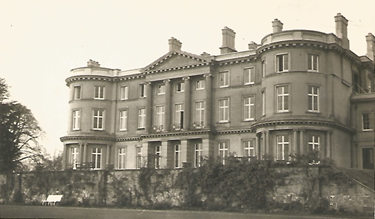Caerleon and Canon Henry Powell Edwards
Caerleon
and Canon Henry Powell Edwards
One of my walks in this lockdown took me through
Caerleon. As I walked past the amphitheatre, the Charles Williams school,
formerly the Endowed Schools, and crossed the road in front of the Museum, I
again marvelled at how much there is to see in Caerleon. I went through the
lychgate of the church and walked to the west door of the church. On the path
to the vicarage I paused like an unintentional pilgrim at the grave of my most
distinguished Victorian predecessor as vicar of Caerleon, Howell Powell Edwards
1827-1897. He is buried in the same grave as his wife Elizabeth who died in
December 1873 at the age of 42 after giving birth to their eleventh child. Also
in the grave are four of those children who died in infancy.
 |
| The grave of Howell Powell Edwards 1827-1897 |
Howell
Powell Edwards became vicar in 1857 after the death of the Revd Daniel Jones,
the grandfather of Arthur Machen. Edwards moved to Caerleon from Llanddewi Fach
where he was succeeded as incumbent by Arthur Machen’s father. Forget Arthur
Machen and concentrate on the man who probably did more for the parish of
Caerleon than any other man in the nineteenth century; he is now largely
unremembered.
Howell
Edwards was born in Llysworney near Cowbridge where his father was perpetual
curate. He went to Jesus College, Oxford where he graduated in 1848. He was
tutor to the Pugh-Evans family in Aberystwyth for a while and he married their
daughter Elizabeth in 1851. They started married life in Llanddewi Fach rectory.
Caerleon vicarage in the north corner of the churchyard was in a state of
disrepair in 1857. The church itself was in a worse state of dilapidation apart
from the chancel, which had just been rebuilt by the architects Prichard and
Seddon at the expense of the patrons, the dean and chapter of Llandaff. The
Endowed schools, where the vicar took a prominent part as trustee/governor,
were overcrowded.
 |
| The Church of St Cadoc in the centre of the Roman Legionary Fortress of Isca, where the principia or headquarters building was situated. |
Young
and energetic, in his early thirties, Howell Edwards started with the rebuilding
of the nave and aisle walls of Caerleon church through Seddon the architect,
who also added the south porch. The vicar then turned his attention to a new
vicarage for which he set up a fund to which John Edward Lee of The Priory,
founder of the Antiquarian Association, gave him £30. The large vicarage in the
north west corner of the churchyard, designed by J.P. Seddon, was completed in
1862. The completion of the rebuilding of the church itself took until 1867.
The attractive extension to the Endowed schools, also by Seddon, was completed
about the same time.
 |
| The Vicarage |
If you stand at the grave of the Revd Howell Powell Edwards, Prebendary of Llandaff and rural dean, you may face east and see the church he rebuilt or north west and see the new vicarage he built. Across the road behind the original School building you will see the attractive extension there. ‘Si monumentum requiris circumspice’.
 |
| The Victorian extension to the Junior School |
Arthur Edwards
Editor’s
note
Revd. Canon Dr Arthur J.
Edwards is
a committee member of the Monmouthshire Antiquarian Association. He has been a
priest in the disestablished Church in Wales for the past forty years. For half
that time, he was a Canon of Newport Cathedral (St Woolos). He served for
twenty years in the Deanery of Pontypool, at Griffithstown and Cwmbran. He was
Chaplain and Head of Religious Studies at the Bishop of LlandafF High School
and Diocesan Director of Education in the Diocese of Monmouth for five years.
He was Vicar of Caerleon and Area Dean of Newport until his retirement in
2012. For his research on the subject of Non-conformism in south-east
Wales, he has been awarded PhD (Wales) 2017.


